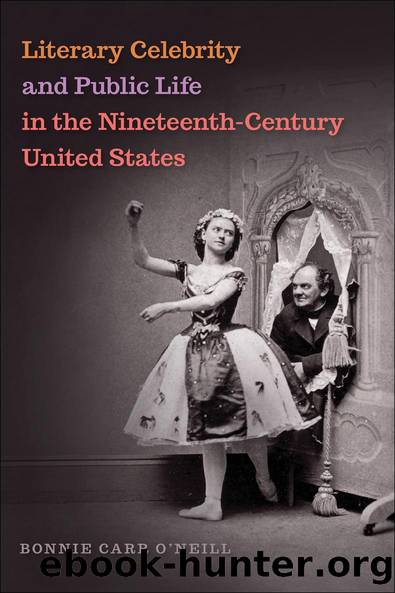Literary Celebrity and Public Life in the Nineteenth-Century United States by Bonnie O'Neill

Author:Bonnie O'Neill [O'Neill, Bonnie]
Language: eng
Format: epub
Tags: Social Science, Popular Culture, Literary Criticism, American, General, History, United States, 19th Century
ISBN: 9780820351575
Google: nSg6DwAAQBAJ
Publisher: University of Georgia Press
Published: 2017-10-15T04:12:09+00:00
CHAPTER 4
FREDERICK DOUGLASS
Celebrity, Privacy, and the Embodied Self
ON AUGUST 11, 1841, FREDERICK DOUGLASS SPOKE BEFORE THE CONvention of the Massachusetts Anti-Slavery Society at Nantucket, Massachusetts. The occasion was not Douglassâs debut as a public speaker; his remarks at an antislavery meeting in New Bedford just two days before had earned him an invitation to Nantucket, and, indeed, Douglass had been honing his oratorical skills since his years in slavery.1 Douglassâs Nantucket appearance nevertheless takes on symbolic importance in his story as the moment at which he became a public figure. It was the first time that William Lloyd Garrison heard Douglass speak, as he reflects in his introduction to Douglassâs Narrative: âI shall never forget his first speech at the conventionâthe extraordinary emotion it excited in my own mindâthe powerful impression it created upon a crowded auditory, completely taken by surpriseâthe applause which followed from the beginning to the end of his felicitous remarks.â2 This notion of surprise is fundamental to Douglassâs career as a public lecturer and antislavery activist: everything about his public performances was at variance with the social expectations and racial presumptions of his audiences. For his part, Douglass played on the rhetorical uses of his surprising publicity in various ways, presenting himself as an eloquent former slave, a mocking critic of slaveryâs logical inconsistencies, and a defiant outsider to the cultural privileges associated with white nationalism.
Douglassâs Nantucket speech initiated his new career as a lecturer, first for the Massachusetts Anti-Slavery Society and then, from 1842, for the American Anti-Slavery Society (AASS). Throughout the 1840s, Douglass rose from obscurity to local notice, then, with the publication of his Narrative in 1845, he became a celebrity of the first order. Significantly, Douglassâs emergence on the national stage coincides with Emersonâs growing celebrity. I have argued that Emersonâs message as a public speaker was complicated by audiencesâ responses to his physical presence on the lecture platform. For Douglass, the significance of his physical presence is shaped by his specific experience in ways that did not affect Emerson or, indeed, most popular lecturers of the moment. Emerson exemplifies a privileged form of public participation made possible in part by an intensely felt and carefully guarded privacy. The case is far different for Douglass, for whom attaining personhood is impossible. Karen Sanchez-Eppler has argued that âfor both women and blacksâ in the public spheres of abolition and womenâs rights, âtheir physical difference from the cultural norms of white masculinity obstructs their claim to personhood.â For black public speakers, the physical self can never be forgotten or ignored: âthe body of the slave attains the status of a textâ by virtue of both the scars of slavery and, according to medical pseudoscience, through anatomical structures that supposedly suit the black body to socially inferior labor and status.3 Audiencesâ responses to black public speakers inevitably conform to prejudgments based on their racialized expectations, which rule out the black speakersâ authority to participate in the debates of the public sphere, let alone to possess the âgeniusâ commonly ascribed to Emerson.
Download
This site does not store any files on its server. We only index and link to content provided by other sites. Please contact the content providers to delete copyright contents if any and email us, we'll remove relevant links or contents immediately.
The Power of Myth by Joseph Campbell & Bill Moyers(1014)
Half Moon Bay by Jonathan Kellerman & Jesse Kellerman(954)
Inseparable by Emma Donoghue(937)
A Social History of the Media by Peter Burke & Peter Burke(936)
The Nets of Modernism: Henry James, Virginia Woolf, James Joyce, and Sigmund Freud by Maud Ellmann(836)
The Spike by Mark Humphries;(766)
The Complete Correspondence 1928-1940 by Theodor W. Adorno & Walter Benjamin(749)
A Theory of Narrative Drawing by Simon Grennan(742)
Culture by Terry Eagleton(724)
Ideology by Eagleton Terry;(696)
Bodies from the Library 3 by Tony Medawar(683)
World Philology by(678)
Farnsworth's Classical English Rhetoric by Ward Farnsworth(674)
Game of Thrones and Philosophy by William Irwin(671)
High Albania by M. Edith Durham(659)
Adam Smith by Jonathan Conlin(648)
A Reader’s Companion to J. D. Salinger’s The Catcher in the Rye by Peter Beidler(647)
Comic Genius: Portraits of Funny People by(616)
Monkey King by Wu Cheng'en(611)
